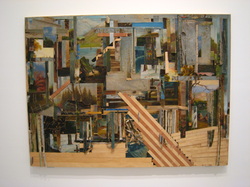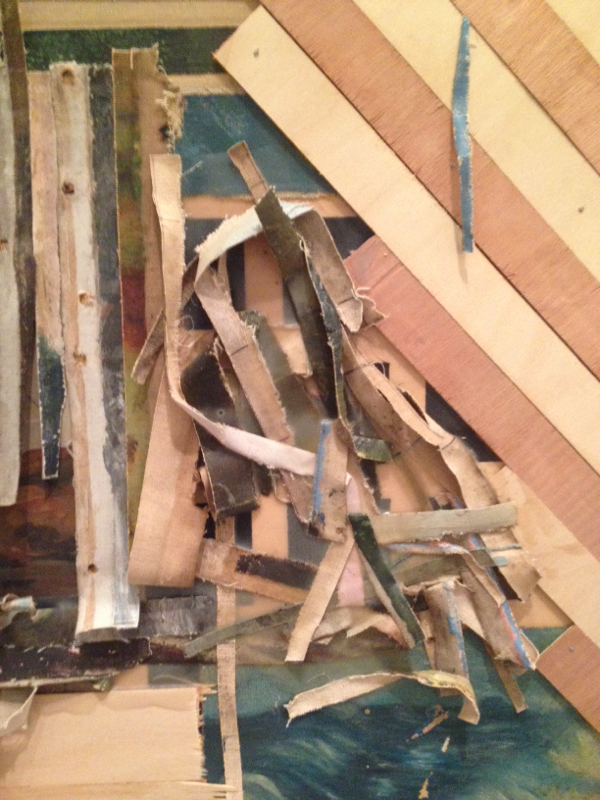Though their exhibited work is distinct from each other both cover themes which I use. Max Gómez Cante, the first prize winner, questions the relationship of the pictorial object to the viewer in his winning work, ¿hmm?. While José Luis Landet uses destruction as a form of creation in his piece, Porosidad. It is his work which I found most provoking because he creates by unsentimentally destroying the paintings of others.
Landet describes his material as fragments of paintings from the 1940s and 50s. These he has slashed in seemingly random strips or cut out the motifs of the paintings, leaving only the background, and reassembled the fragments haphazardly. What was no doubt lovingly created works, of mountains, lakes, forests and sea, are now reduced to their material value. I find it sad that a once loved view, cherished by the artist or the owner of the work, can no longer be seen. And yet, I imagine Lancet picked up his source material from flea markets or junk shops. In the UK there are certainly many discarded paintings in charity shops and I have considered using them as a source material as well. If they have already been rejected, why not recycle and reuse? But I find the wanton destruction of other artists' work difficult to deal with because it could so easily be my work that shares a same fate, or that of Lancet.
I tried to reconcile the layers of landscape into something recognisable as a whole. Did the strips of plywood collected together at the bottom and jutting into the mid-ground signify a jetty of some kind, the rest a lake? We're perhaps the strips ordered thematically which is why canvas edges are collected together in the centre of the piece? Instead, the details remaining from each picture drew me in: a bird sitting on a branch, a flock flying into the sunset, a fisherman by a lake. Details I might not have chosen to look at given the whole picture but revealed by the absence of the rest. Maybe this destruction isn't unsympathetic yo the original material afterall.
The work of the prize winner, Max Gómez Cante's ¿hmm? was two beautifully crafted frames through which he literally pushed his paintings to the edge, leaving the viewer with an expanse of white wall at the centre of the works. The order of frame and picture are reversed, when looking from outside in. If my translation from the spanish is correct, he describes this as posing a question for the observer about the relationship of the pictorial object and it's history. The paintings themselves, what I could glimpse of them, we're romanticised landscapes. Fields turning into hills into mountains as the eye moves from fore to mid to background. The hues changing from brown and green to purple to blue. They were similar to the landscapes destroyed by José Luis Landet and, as in his work, I found them captivating because I was not presented with the whole image.
This is probably my penultimate post before I have to hand over the Reside Residency baton to the next artist. If you'd like it to be you, you have until Sunday 26 January, 5 pm UK time to apply. Please take a look at the application information and send your submission via the contact form on this site.
I'll announce the next artist in my last post on the 31 January.



 RSS Feed
RSS Feed
